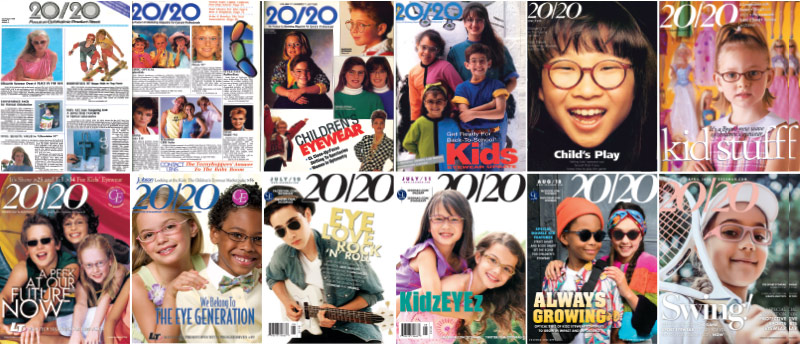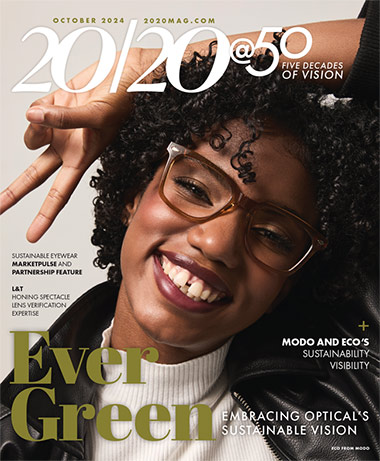

By Christine Yeh
Children’s eyewear has come a long way over the past 50 years. In the early ’70s, the amount of frame styles for kids were quite limited. One of the earliest features on children’s eyewear in the September/October 1976 issue of 20/20 described the choices for kids’ eyewear in a typical dispenser’s office could be counted on one hand. “It used to be that in designing for kids, manufacturers took a simple and painfully plain adult frame and scaled it down for smaller faces. In this sense, children’s frames were an afterthought with precious little thought given to variety,” the article explained. During that time, eyewear manufacturers began to consider other factors in designing children’s eyewear and adapting them to meet the fit requirements of young faces and their developing features. More consideration was given to style and fashion, and lifestyle became an important factor as well—kids are active, and they need frames that can withstand their daily movements, making durability, safety and flexibility top priorities. The widespread growth of plastic lenses as well as new developments in hinge construction also played significant roles in expanding frame options for kids.
In the 1980s, more eyewear vendors began to recognize the opportunities that remain untapped in the children’s eyewear market. Children needing vision correction continued to increase and along with it, the demand for more eyewear choices. In an effort to appeal to children and their parents, manufacturers began to partner with popular and well-known brands for eyewear licenses. Famous cartoons, television shows, apparel and toy brands, anything that resonated with the desires of children, made their way onto kids’ frames along with their related brand marketing. Evolving style trends in frame designs for adults also drove the expansion of options for children. Overall, the children’s eyewear category saw a growing share in the market as we approached the ’90s, but challenges still remained in merging these growth opportunities with selling successfully to this group and helping eyecare professionals make the children’s market a larger and more profitable piece of their dispensary. This market is unique in the sense that there are two sets of customers: the child wearing the eyewear and the parent/adult purchasing it for them.
To help bridge this gap, 20/20 strengthened our editorial coverage on children’s eyewear. In addition to enhanced content on new children’s eyewear collections, we intensified our coverage in providing optical retailers with expert insight and tips on dispensing and selling to children and their parents. We created a special supplement on kids’ eyewear with Vision Monday, known today as KidzBiz, a partnership initiative with children’s eyewear vendors to feature the latest frames for young faces. Our annual Children’s Eyewear MarketPulse Survey conducted by Jobson Research highlights facts and figures on market and dispensing trends in kids’ eyewear. We also took the lead in heightening awareness on relevant topics related to children’s eyecare and eyewear such as special fitting needs, myopia control and the importance of UV protection, and protective sport and safety eyewear for young eyes, many of which are featured in our L&T and Pro to Pro educational articles, and ABO and NCLE approved CE courses.
In more recent decades, the style trends in children’s eyewear witnessed more growth than ever. Children, particularly tweens and teens, have become more discerning and brand conscious when it comes to selecting their frames. Many young wearers have also looked beyond popular lifestyle brands, choosing frames with design and style traits seen in eyewear for adults, resulting in more independent eyewear brands creating frames for these young eyewear fans. Overall, we are seeing an impressive assortment of style options that run the gamut—a kaleidoscope of colors and bright prints; sparkles, glitter and bejeweled embellishments; classic and fun shapes; a healthy balance of plastic, metal and combination styles. But perhaps among the biggest change we have seen in children’s eyewear offerings is more sunwear. We have long been touting the importance of sunglasses for young eyes, and while strides have been made, we still have a long way to go in this area.
As we celebrate our 50th anniversary this year, we are proud to continue delivering this coverage on children’s eyewear and reinforcing the vital role we continue to play in helping to shape this category into a viable segment of the eyecare professional’s business. We’re not kidding when we say kids’ eyewear is big business but more importantly, children’s vision is our tomorrow, and we must keep our eyes on framing the faces of our future. ■






















